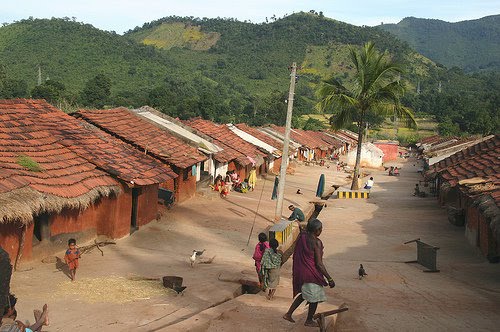
For over two months now, the controversial, Citizenship Amendment Bill (CAA) 2019 has generated widespread debate and opposition given its exclusivist character. What has received relatively less mention is the threat to the Adivasi and Forest dweller dominated Vth Schedules areas that remain unprotected under the amendment: the real threat is that “newly made citizens could be re-settled here” threatening land rights of the indigenous as also their culture and language.
An article by Gladson Dungdung writer and researcher from the Kharia community brings this out. He has dubbed it an “Invasion of Fifth Schedule Area(s).”
Paragraph 4, Section 3 of the CAA states that it will not be enforced in the Sixth Schedule Areas; this was primarily and belatedly brought in to assuage sentiments of persons in the states in the North-East. Scheduled areas are constitutionally set-up regions that were put into effect to protect Adivasis, forest dwellers and indigenous peoples. However while the Sixth Schedule Areas are protected under the CAA 2019, the Fifth Schedule areas are not.
This could mean that newly made citizens will be resettled in the Fifth Schedule Areas. In 2011, India received 5.4 million immigrants, of which Bangladeshi immigrants were the largest group, who are locally referred to as ‘intruders’ by some. If these immigrants are resettled in the Fifth Schedule Areas, Adivasis fear that territory and land resources could be contested. This possible strain on the Adivasis territory and resources, will further deepen the livelihood crisis that they face.
Already, illegal land alienation of Adivasis is one of the major concerns for the Fifth Schedule Areas. Despite having special legislations for safeguarding the land of Adivasis, like the Chhotanagpur Tenancy Act 1908, Santal Pargana Tenancy Act 1949 and Land Revenue Code in all the Fifth Schedule states, illegal land alienation was not curbed.
According to the 2002-2003 annual report of the Ministry of Rural Development: 60,464 cases comprising 85,777.22 acres of illegally transferred tribal land were registered between 2001-2002. Out of these, 34,608 cases (comprising 46,797.36 acres) were considered for a legal hearing, while the rest of the cases were dismissed. However, after the hearing, only 21,445 cases (comprising 29,829.7 acres) were given possession to the original holders and the rest remained with non-Adivasis.
This land alienation continues unabated. Over 2,600 cases of illegal land transfers were registered in 2003-2004; over 2,650 cases in 2004-2005; over 3,200 cases in 2005-2006; over 3780 cases in 2006-2007; and over 5,380 cases in 2007-2008. This clearly indicates that cases of illegal land alienation are increasing rapidly.
It is feared by many Adivasis that the NRC/CAA will further increase the cases of land alienation, and once the ‘intruders’ are relocated in Fifth Schedule Areas, it is further feared they will start grabbing Adivasis land.
Demographic change
The NRC/CAA will have direct impact on the demography of Fifth Schedule Areas. If the so-called ‘intruders’ are given citizenship under the CAA and relocated to Fifth Schedule Areas, this could result in an increase of the general population and a decline of the Adivasi population, as has already been seen due to the influx of the general population caused by rapid industrialisation.
The state of Jharkhand is a crucial example to understand the demographic change caused by the influx of mainstream populations. The state was formed in 2000. In the early 1950s the tribal population of the region was 36 per cent of the total population, however by 2011 it has declined to 26.2 per cent as non-tribals moved into the state.
Similarly, before the establishment of the Tata Steel Company in 1907 in Sakchi and Kalamati, in the East Singhbhum district of Jharkhand, 95 per cent of the population in the region were Adivasis. In 2011 that population drastically decreased to only 5 per cent.[11] Almost all the Indian cities that have been developed on Adivasis land have more or less experienced the same changes.
Such demographic changes will have a direct impact on the reservation status of these protected areas. If the population of Adivasis decreases, the reserved seats for them in government jobs, the Legislative Assembly and Parliament will also decrease, effectively engineering the NRC/CAA as a tool for the extinction of the Adivasis.
Impact on Language and culture
The NRC/CAA will also have an impact on the language and culture of the Adivasis. In the areas where Adivasis population has decreased due to industrialisation and urbanisation, Adivasis have lost their languages and culture. The Adivasis are termed as uncivilised, barbarians, backward and primitive by the general population, and at the same time, the government attempts to assimilate Adivasis through mainstreaming, which continues the process of erasing language and culture. Therefore, the fear of so-called ‘intruders’ relocated to Fifth Schedule Areas also translates into a threat to Adivasis languages and culture.
There is no question that the NRC/CAA will have an adverse effect on the Adivasis of the Fifth Schedule Areas across 10 states in India. If the NRC/CAA is enforced nationwide, millions of Adivasis will lose their citizenship, be detained in detention camps and ‘intruders’ will be relocated to Adivasis land, impacting population, land tenure, resource management and cultural loss. This must not be allowed.
Adivasis are the first settlers of India, therefore, they must be excluded from the NRC/CAA. The civil and political rights, as well as the economic, social and cultural rights, of Adivasis, which need to be protected, are now under their gravest threat.
This is based on an article by reseatch scholar Gladson Dungdung in IWGIA a global human rights organisation dedicated to promoting, protecting and defending indigenous peoples’ rights.